Sustainability Indicators of Different Production Systems of a Greek Local Sheep Breed
Abstract
1. Introduction
2. Materials and Methods
2.1. Case Study
- Specialized Livestock farms (SLf): Pasture-based farms specializing in milk and meat with no cultivated land, so all feedstuff (concentrates and forage in winter) is purchased from markets.
- Partially Mixed farms (Mixed [L]): Livestock farms that cultivate crops for feedstuff (forage and concentrates).
- Mixed Livestock–Crop farms (Mixed [L + C]): Farms combining livestock and crop production both for feedstuff and for markets. Apart from corn, barley, and alfalfa, Mixed [L + C] farms engage in cotton production which is a crop of strategic importance for Thessaly.
2.2. Development of the Sustainability Indicators Toolkit
- “Relevance”: Ensures that the selected SI aligns with the contextualization of the study (e.g., objectives, spatial and temporal scale, etc.).
- “Applicability”: The selected SIs are applicable in other frameworks and settings, and data for calculation can be easily retrieved.
- “End-user values”: The SIs are easily understandable by the target audience.
| Sustainability Dimension | Sub-Theme | Indicator | Definition/Calculation Formula | Unit | Threshold | Source |
|---|---|---|---|---|---|---|
| Economic | Profitability | Gross revenues | The sum of revenues, which was calculated with and without income support from the Common Agricultural Policy (CAP) 2014–2020 | EUR/ewe | min–max | [26] |
| Total production cost | The sum of production expenses (i.e., total expenses for Labor, Land and Capital) | EUR/ewe | min-max | [1,26] | ||
| Purchased feedstuff expenses | Cost of purchased feedstuff | EUR/ewe | min–max | [26] | ||
| Crop production expenses | Cost of seeds, fertilizers, pesticides, fuel, etc. | EUR/ewe | min–max | [1,26] | ||
| Net profit/loss | Gross revenues minus total production costs. Net profit loss was calculated with and without income support from CAP 2014–2020 | EUR/ewe | min–max | [1,26] | ||
| Farm Family income | Gross revenues minus explicit costs. Farm Family income was calculated with and without income support from CAP 2014–2020 | EUR/ewe | min–max | [1,26] | ||
| Productivity | Milk yield | This indicator refers to the total milked quantity per ewe | liters/ewe | min–max | [26] | |
| Diversification | No. of income sources | Number of different income sources (e.g., income from livestock products, cotton, corn, alfalfa, etc.). Livestock products constitute a single category | Scale | 1–max | [1] | |
| Self-resilience | Subsidy dependence | Subsidies/total income | % | min–max | [1] | |
| Feedstuff self-sufficiency | On-farm feeding cost/total feeding cost 1 | % | min–max | [1] | ||
| Environmental | Use of energy | Efficiency of energy use | Gross output/Cost of energy (electricity, fuel, etc.)/ 2 | EUR/EUR gross output | min–max | [47] |
| Agrochemical Inputs | Fertilizers use | - | Kg/ha | min–max | [7] | |
| Pesticides use | - | Lt/ha | min–max | [7] | ||
| Nutrients | Nitrogen | - | Kg/ha | min–max | [7] | |
| Phosphorus | - | Kg/ha | min–max | [7] | ||
| Irrigation practices | Total irrigated area | - | ha | min–max | [32,33,47] | |
| Low efficiency irrigation systems coverage 3 | Total ha irrigated by surface irrigation systems/Total irrigated area | % | 0–100 | [31,47] | ||
| Medium efficiency irrigation sytems coverage 3 | Total ha irrigated by overhead (e.g., center pivot) and sprinkler systems/Total irrigated area | % | 0–100 | [31,47] | ||
| Highly efficiency irrigation sytems coverage 3 | Total ha irrigated by drip irrigation system/Total irrigated area | % | 0–100 | [31,47] | ||
| Social | Social Welfare | Satisfaction with quality of life | We asked farmers to rate their quality of life on a scale from 0 to 5, where 0 = ‘very poor’ and 5 = ‘very good’. | Median | 0–5 | [31,48] |
| Job Satisfaction | We asked farmers to rate their job satisfaction on a scale from 0 to 5, where 0 = ‘not at all’ and 5 = ‘very much’ | Median | 0–5 | [31,48] | ||
| Holidays per year | We asked farmers how many times per year they go on vacation | Median | 0–max | [31,48] | ||
| Employment and working conditions | Working conditions: Replacement during illness | Percentage of farmers that have a family member to replace them in case of illness or injury. | % | 0–100 | [31] | |
| Continuity of farm | Continuity of farm in the next 5–10 years | We asked farmers whether they plan to remain in the sector over the next 5 to 10 years. | % of positive answers | 0–max | [31] | |
| Continuity of farm in the long term (over ten years) | We asked farmers if they plan to remain in the sector in the long term. | % of positive answers | 0–max | [31] |
2.3. Data Collection and Analysis
3. Results—Discussion
4. Conclusions
Supplementary Materials
Author Contributions
Funding
Institutional Review Board Statement
Informed Consent Statement
Data Availability Statement
Acknowledgments
Conflicts of Interest
References
- Ripoll-Bosch, R.; Joy, M.; Bernués, A. Role of self-sufficiency, productivity and diversification on the economic sustainability of farming systems with autochthonous sheep breeds in less favoured areas in Southern Europe. Animal 2014, 8, 1229–1237. [Google Scholar] [CrossRef] [PubMed]
- Mądry, W.; Mena, Y.; Roszkowska-Mądra, B.; Gozdowski, D.; Hryniewski, R.; Castel, J.M. An overview of farming system typology methodologies and its use in the study of pasture-based farming system: A review. Span. J. Agric. Res. 2013, 11, 316–326. [Google Scholar] [CrossRef]
- Bernués, A.; Ruiz, R.; Olaizola, A.; Villalba, D.; Casasús, I. Sustainability of pasture-based livestock farming systems in the European Mediterranean context: Synergies and trade-offs. Livest. Sci. 2011, 139, 44–57. [Google Scholar] [CrossRef]
- Hadjigeorgiou, I. Past, present and future of pastoralism in Greece. Pastoralism 2011, 1, 24. [Google Scholar] [CrossRef]
- Theodoridis, A.; Ragkos, A.; Zaralis, K.; Smith, L.; Arsenos, G. Towards a pan-European typology of sheep and goat farms: A meta analysis. In Innovation for Sustainability in Sheep and Goats, Proceedings of the 2nd Joint Seminar of the Sub-networks on Nutrition and on Production Systems of the FAO-CIHEAM Network for Research and Development in Sheep and Goats, Vitoria-Gasteiz, Spain, 3–5 October 2017; CIHEAM: Paris, France, 2017; pp. 3–5. [Google Scholar]
- FAO. Sustainable Livestock Transformation—A Vision for FAO’s Work on Animal Production and Health; FAO: Rome, Italy, 2023. [Google Scholar] [CrossRef]
- Masi, M.; Vecchio, Y.; Pauselli, G.; Di Pasquale, J.; Adinolfi, F. A Typological Classification for Assessing Farm Sustainability in the Italian Bovine Dairy Sector. Sustainability 2021, 13, 7097. [Google Scholar] [CrossRef]
- Rodríguez-Ortega, T.; Bernués, A.; Olaizola, A.; Brown, M. Does intensification result in higher efficiency and sustainability? An emergy analysis of Mediterranean sheep-crop farming systems. J. Clean. Prod. 2017, 144, 171–179. [Google Scholar] [CrossRef]
- Ragkos, A.; Koutouzidou, G.; Koutsou, S.; Roustemis, D. A new development paradigm for local animal breeds and the role of information and communication technologies. In Innovative Approaches and Applications for Sustainable Rural Development: 8th International Conference, HAICTA 2017, Chania, Crete, Greece, 21–24 September 2017; Selected Papers 8; Springer International Publishing: Berlin/Heidelberg, Germany, 2019; pp. 3–21. [Google Scholar] [CrossRef]
- Varela, E.; Kallas, Z. Extensive Mediterranean agroecosystems and their linked traditional breeds: Societal demand for the conservation of the Majorcan black pig. Land Use Policy 2022, 112, 105848. [Google Scholar] [CrossRef]
- Ripoll-Bosch, R.; Díez-Unquera, B.; Ruiz, R.; Villalba, D.; Molina, E.; Joy, M.; Olaizola, A.; Bernués, A. An integrated sustainability assessment of mediterranean sheep farms with different degrees of intensification. Agric. Syst. 2012, 105, 46–56. [Google Scholar] [CrossRef]
- Neal, M.; Roche, J.R. Profitable and resilient pasture-based dairy farm businesses in New Zealand. Anim. Prod. Sci. 2019, 60, 169–174. [Google Scholar] [CrossRef]
- Ragkos, A.; Koutsou, S.; Manousidis, T. In Search of Strategies to Face the Economic Crisis: Evidence from Greek Farms. South Eur. Soc. Politics 2016, 21, 319–337. [Google Scholar] [CrossRef]
- Gillespie, J.; Nehring, R. Pasture-Based versus Conventional Milk Production: Where Is the Profit? J. Agric. Appl. Econ. 2014, 46, 543–558. [Google Scholar] [CrossRef]
- Díaz-Gaona, C.; Sánchez-Rodríguez, M.; Rodríguez-Estévez, V. Assessment of the Sustainability of Extensive Livestock Farms on the Common Grasslands of the Natural Park Sierra de Grazalema. Sustainability 2021, 13, 1818. [Google Scholar] [CrossRef]
- Nori, M. Migrant Shepherds: Opportunities and Challenges for Mediterranean Pastoralism. Rev. De Geogr. Alp. J. Alp. Res. 2017. [Google Scholar] [CrossRef]
- Delattre, L.; Debolini, M.; Paoli, J.C.; Napoleone, C.; Moulery, M.; Leonelli, L.; Santucci, P. Understanding the Relationships between Extensive Livestock Systems, Land-Cover Changes, and CAP Support in Less-Favored Mediterranean Areas. Land 2020, 9, 518. [Google Scholar] [CrossRef]
- Ryschawy, J.; Choisis, N.; Choisis, J.P.; Joannon, A.; Gibon, A. Mixed crop-livestock systems: An economic and environmental-friendly way of farming? Animal 2012, 6, 1722–1730. [Google Scholar] [CrossRef]
- Veysset, P.; Lherm, M.; Bébin, D.; Roulenc, M. Mixed crop–livestock farming systems: A sustainable way to produce beef? Commercial farms results, questions and perspectives. Animal 2014, 8, 1218–1228. [Google Scholar] [CrossRef]
- Battaglini, L.; Bovolenta, S.; Gusmeroli, F.; Salvador, S.; Sturaro, E. Environmental Sustainability of Alpine Livestock Farms. Ital. J. Anim. Sci. 2014, 13, 3155. [Google Scholar] [CrossRef]
- Micha, E.; Heanue, K.; Hyland, J.J.; Hennessy, T.; Dillon, E.J.; Buckley, C. Sustainability levels in Irish dairy farming: A farm typology according to sustainable performance indicators. Stud. Agric. Econ. 2017, 119, 62–69. [Google Scholar] [CrossRef]
- Tzouramani, I.; Mantziaris, S.; Karanikolas, P. Assessing Sustainability Performance at the Farm Level: Examples from Greek Agricultural Systems. Sustainability 2020, 12, 2929. [Google Scholar] [CrossRef]
- Dantsis, T.; Douma, C.; Giourga, C.; Loumou, A.; Polychronaki, E.A. A methodological approach to assess and compare the sustainability level of agricultural plant production systems. Ecol. Indic. 2010, 10, 256–263. [Google Scholar] [CrossRef]
- de Olde, E.M.; Bokkers, E.A.; de Boer, I.J. The Choice of the Sustainability Assessment Tool Matters: Differences in Thematic Scope and Assessment Results. Ecol. Econ. 2017, 136, 77–85. [Google Scholar] [CrossRef]
- Papanikolopoulou, V.; Vouraki, S.; Priskas, S.; Theodoridis, A.; Dimitriou, S.; Arsenos, G. Economic Performance of Dairy Sheep Farms in Less-Favoured Areas of Greece: A Comparative Analysis Based on Flock Size and Farming System. Sustainability 2023, 15, 1681. [Google Scholar] [CrossRef]
- Papadopoulou, A.; Ragkos, A.; Theodoridis, A.; Skordos, D.; Parissi, Z.; Abraham, E. Evaluation of the Contribution of Pastures on the Economic Sustainability of Small Ruminant Farms in a Typical Greek Area. Agronomy 2020, 11, 63. [Google Scholar] [CrossRef]
- Vouraki, S.; Skourtis, I.; Psichos, K.; Jones, W.; Davis, C.; Johnson, M.; Rupérez, L.R.; Theodoridis, A.; Arsenos, G. A Decision Support System for Economically Sustainable Sheep and Goat Farming. Animals 2020, 10, 2421. [Google Scholar] [CrossRef] [PubMed]
- Fousekis, P.; Spathis, P.; Tsimboukas, K. Assessing the efficiency of sheep farming in mountainous areas of Greece. A non parametric approach. Agric. Econ. Rev. 2001, 2, 5–15. [Google Scholar] [CrossRef]
- Tzouramani, I.; Zelovitis, J.; Intxaurrandieta, J.M.; Eguinoa, P. Sustainability of the dairy sheep farming: Examples from Greece and Spain. In Options Méditerranéennes: Série A. Séminaires Méditerranéens; CIHEAM: Paris, France, 2019; pp. 457–461. [Google Scholar]
- Sintori, A.; Tsiboukas, K.; Zervas, G. Evaluating socio-economic and environmental sustainability of the sheep farming activity in Greece: A whole-farm mathematical programming approach. In Methods and Procedures for Building Sustainable Farming Systems: Application in the European Context; Springer: Dordrecht, The Netherlands, 2013; pp. 219–235. [Google Scholar] [CrossRef]
- Latruffe, L.; Desjeux, Y.; Dupraz, P. Database Used for FLINT WP5 Activities: Description and Quality Assessment. 2016. Available online: https://hal.science/hal-01611417/file/FLINT%20D5.1_%7BF30237D6-96EC-4E9D-80DD-C98CF85F36CC%7D.pdf (accessed on 5 August 2024).
- Montes, L.V.; Ruiz, A.M. Environmental indicators to evaluate spatial and water planning in the coast of Granada (Spain). Land Use Policy 2008, 25, 95–105. [Google Scholar] [CrossRef]
- Meier, J.; Zabel, F.; Mauser, W. A global approach to estimate irrigated areas—A comparison between different data and statistics. Hydrol. Earth Syst. Sci. 2018, 22, 1119–1133. [Google Scholar] [CrossRef]
- Argyropoulos, C.; Petrakis, T.; Roditi, L.-A.; Kavga, A. Opportunities and Potential for Energy Utilization from Agricultural and Livestock Residues in the Region of Thessaly. Sustainability 2023, 15, 4429. [Google Scholar] [CrossRef]
- Loukas, A.; Vasiliades, L.; Tzabiras, J. Evaluation of climate change on drought impulses in Thessaly, Greece. Eur. Water 2007, 17, 17–28. [Google Scholar]
- ELSTAT. Holdings and Number of Animals, Reference Year 2016. Hellenic Statistical Authority. Available online: https://www.statistics.gr/en/statistics/-/publication/SPK12 (accessed on 23 October 2024).
- Lazoglou, G.; Papadopoulos-Zachos, A.; Georgiades, P.; Zittis, G.; Velikou, K.; Manios, E.M.; Anagnostopoulou, C. Identification of climate change hotspots in the Mediterranean. Sci. Rep. 2024, 14, 29817. [Google Scholar] [CrossRef]
- Adamopoulos, I.; Frantzana, A.; Syrou, N. Climate Crises Associated with Epidemiological, Environmental, and Ecosystem Effects of a Storm: Flooding, Landslides, and Damage to Urban and Rural Areas (Extreme Weather Events of Storm Daniel in Thessaly, Greece). Med. Sci. Forum 2024, 25, 7. [Google Scholar] [CrossRef]
- Meletis, E.; Jarynowski, A.; Maksymowicz, S.; Kostoulas, P.; Belik, V. Animal Health Discourse during Ecological Crises in the Media—Lessons Learnt from the Flood in Thessaly from the One Health Perspective. Veter. Sci. 2024, 11, 140. [Google Scholar] [CrossRef] [PubMed]
- Hellenic Republic-Region of Thessaly. Strategic Plan for the Sustainable Agricultural Production of Thessaly. Available online: https://www.thessaly.gov.gr/images/right/sxedio.pdf (accessed on 1 December 2024).
- Perucho, L.; Hadjigeorgiou, I.; Lauvie, A.; Moulin, C.-H.; Paoli, J.-C.; Ligda, C. Challenges for local breed management in Mediterranean dairy sheep farming: Insights from Central Greece. Trop. Anim. Health Prod. 2019, 51, 329–338. [Google Scholar] [CrossRef] [PubMed]
- MINAGRIC: Hellenic Ministry of Rural Development and Food. Local Sheep Breeds. 2015. Available online: https://www.minagric.gr/component/content/article/1075-autofilesaigoprobaton?catid=727&Itemid=604 (accessed on 25 September 2024).
- SilentResident, Philly Boy92. The Location of Thessaly Within Greece. Available online: https://commons.wikimedia.org/wiki/File:Location_map_of_Thessaly_(Greece).svg (accessed on 22 October 2024).
- Google. [the Regions of Thessaly]. Available online: https://www.google.com/maps (accessed on 22 October 2024).
- Livestock Genetic Resources Centre of Karditsa, Karditsa, Greece. Population of Purebred Karagkouniko Sheep Registered in Herdbooks. Personal communication, 26 July 2024.
- Lebacq, T.; Baret, P.V.; Stilmant, D. Sustainability indicators for livestock farming. A review. Agron. Sustain. Dev. 2013, 33, 311–327. [Google Scholar] [CrossRef]
- Kelly, E.; Ryan, M.; Finn, J.; Hennessy, T.F. D1: Farm-Level Indicators for Evaluating Sustainability and Emerging New Policy Topics. 2015. [Google Scholar]
- Ruiz, F.A.; Mena, Y.; Sayadi, S.; Castel, J.M.; Navarro, L.; Nahed, J. Social indicators for evaluating sustainability of goat livestock farms: Methodological approach. Trop. Subtrop. Agroecosyst. 2009, 11, 65–68. [Google Scholar]
- Munir, M.S.; Bajwa, I.S.; Naeem, M.A.; Ramzan, B. Design and Implementation of an IoT System for Smart Energy Consumption and Smart Irrigation in Tunnel Farming. Energies 2018, 11, 3427. [Google Scholar] [CrossRef]
- Mosnier, C.; Benoit, M.; Minviel, J.J.; Veysset, P. Does mixing livestock farming enterprises improve farm and product sustainability? Int. J. Agric. Sustain. 2022, 20, 312–326. [Google Scholar] [CrossRef]
- de Rancourt, M.; Fois, N.; Lavín, M.; Tchakérian, E.; Vallerand, F. Mediterranean sheep and goats production: An uncertain future. Small Rumin. Res. 2006, 62, 167–179. [Google Scholar] [CrossRef]
- Theodoridis, A.; Vouraki, S.; Morin, E.; Rupérez, L.R.; Davis, C.; Arsenos, G. Efficiency Analysis as a Tool for Revealing Best Practices and Innovations: The Case of the Sheep Meat Sector in Europe. Animals 2021, 11, 3242. [Google Scholar] [CrossRef]
- Micha, E.; Gorny, H.; Powell, J.R.; Mantino, F.; Khafagy, A.; Dwyer, J.C.; Andronic, C.; Kirchmayr-Novak, S.; Münch, A.; Gaugitsch, R.; et al. Evaluation Support Study on the Impact of the CAP on Territorial Development of Rural Areas. Socioeconomic Aspects. 2021. Available online: https://op.europa.eu/en/publication-detail/-/publication/08e60401-71a0-11eb-9ac9-01aa75ed71a1/language-en (accessed on 23 October 2024).
- Liontakis, A.; Tzouramani, I. Economic Sustainability of Organic Aloe Vera Farming in Greece under Risk and Uncertainty. Sustainability 2016, 8, 338. [Google Scholar] [CrossRef]
- Salinas-Martínez, J.A.; Posadas-Domínguez, R.R.; Ángeles-Hernández, J.C.; Morales-Díaz, L.D.; Rebollar-Rebollar, S.; Rojo-Rubio, R.; Arriaga-Jordán, C.M. The economic effects of grazing in small-scale lamb fattening production systems in central México through a scenario analysis. Trop. Anim. Health Prod. 2022, 54, 233. [Google Scholar] [CrossRef] [PubMed]
- Läpple, D.; Hennessy, T.; O’donovan, M. Extended grazing: A detailed analysis of Irish dairy farms. J. Dairy Sci. 2012, 95, 188–195. [Google Scholar] [CrossRef] [PubMed]
- Sánchez, A.C.; Kamau, H.N.; Grazioli, F.; Jones, S.K. Financial profitability of diversified farming systems: A global meta-analysis. Ecol. Econ. 2022, 201, 107595. [Google Scholar] [CrossRef]
- Benoit, M.; Laignel, G. Energy consumption in mixed crop-sheep farming systems: What factors of variation and how to decrease? Animal 2010, 4, 1597–1605. [Google Scholar] [CrossRef]
- UN DESA. The Sustainable Development Goals Report 2024–June 2024. New York, USA: UN DESA. © UN DESA. 2024. Available online: https://unstats.un.org/sdgs/report/2024/ (accessed on 7 December 2024).
- Deguine, J.P.; Ferron, P.; Russell, D. Sustainable pest management for cotton production: A review. In Sustainable Agriculture; Springer: Dordrecht, The Netherlands, 2009; pp. 411–442. [Google Scholar] [CrossRef]
- European Commission. A Roadmap for Moving to a Competitive Low Carbon Economy in 2050; European Commission: Brussels, Belgium, 2011. [Google Scholar]
- Khalifa, W.M.A.; Gasmi, H.; Butt, T.A. Farm-Based Environmental and Economic Impacts of the Drip Irrigation System. Eng. Technol. Appl. Sci. Res. 2020, 10, 6335–6343. [Google Scholar] [CrossRef]
- Alcon, F.; Navarro, N.; De-Miguel, M.D.; Balbo, A.L. Drip Irrigation Technology: Analysis of Adoption and Diffusion Processes. In Sustainable Solutions for Food Security: Combating Climate Change by Adaptation; Springer: Cham, Switzerland, 2019; pp. 269–285. [Google Scholar] [CrossRef]
- Duval, J.; Cournut, S.; Hostiou, N. Livestock farmers’ working conditions in agroecological farming systems. A review. Agron. Sustain. Dev. 2021, 41, 22. [Google Scholar] [CrossRef]
- Nori, M. Integrating immigrant workforce in European pastoralism: Reality, policy and practices. Ital. Rev. Agric. Econ. 2021, 76, 49–58. [Google Scholar]
- Ragkos, A.; Koutsou, S.; Theodoridis, A.; Manousidis, T.; Lagka, V. Labor management strategies in facing the economic crisis. Evidence from Greek livestock farms. New Medit 2018, 17, 59–71. [Google Scholar] [CrossRef]
- Latruffe, L.; Balcombe, K.; Davidova, S.; Zawalinska, K. Technical and scale efficiency of crop and livestock farms in Poland: Does specialization matter? Agric. Econ. 2005, 32, 281–296. [Google Scholar] [CrossRef]
- van der Linden, A.; de Olde, E.M.; Mostert, P.F.; de Boer, I.J. A review of European models to assess the sustainability performance of livestock production systems. Agric. Syst. 2020, 182, 102842. [Google Scholar] [CrossRef]
- Kanter, D.R.; Musumba, M.; Wood, S.L.R.; Palm, C.; Antle, J.; Balvanera, P.; Dale, V.H.; Havlik, P.; Kline, K.L.; Scholes, R.J.; et al. Evaluating agricultural trade-offs in the age of sustainable development. Agric. Syst. 2018, 163, 73–88. [Google Scholar] [CrossRef]
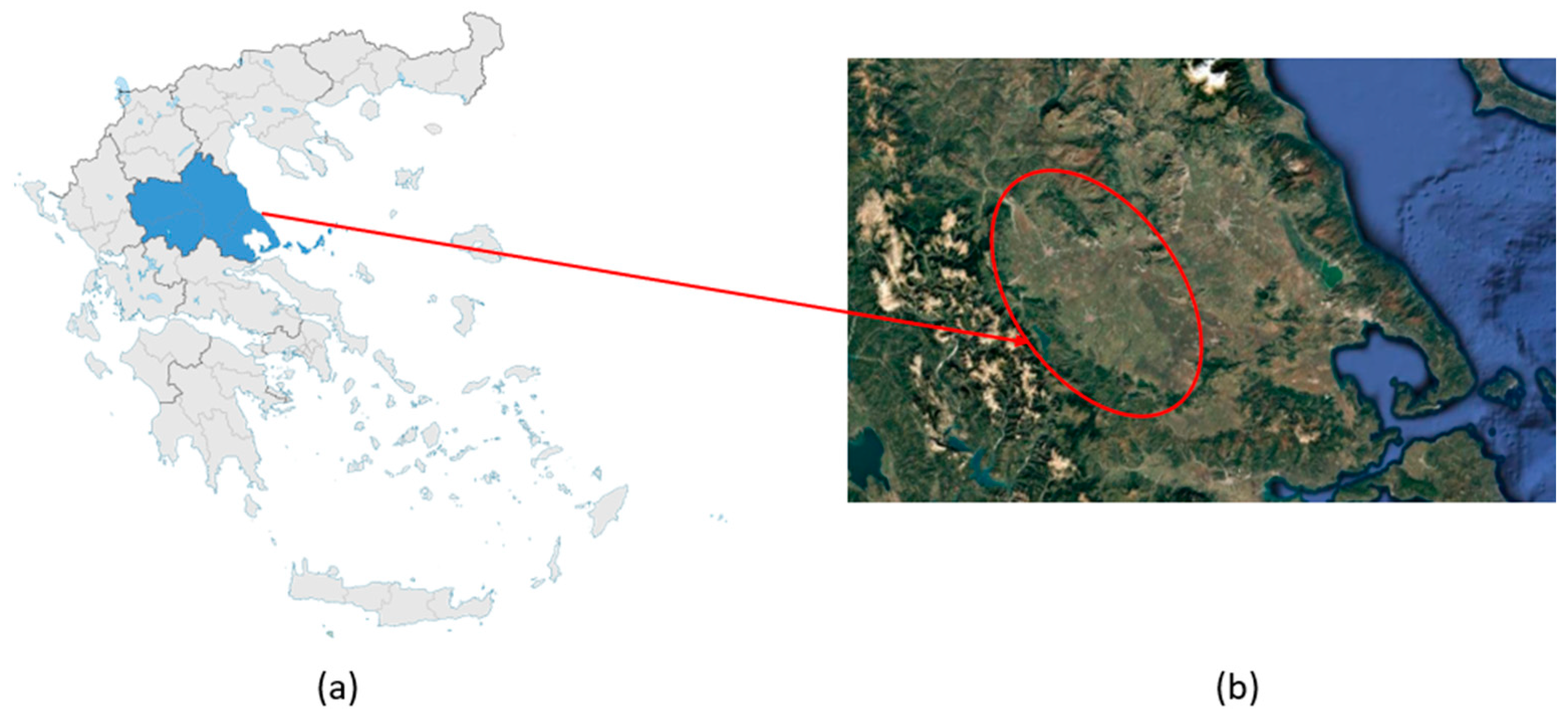

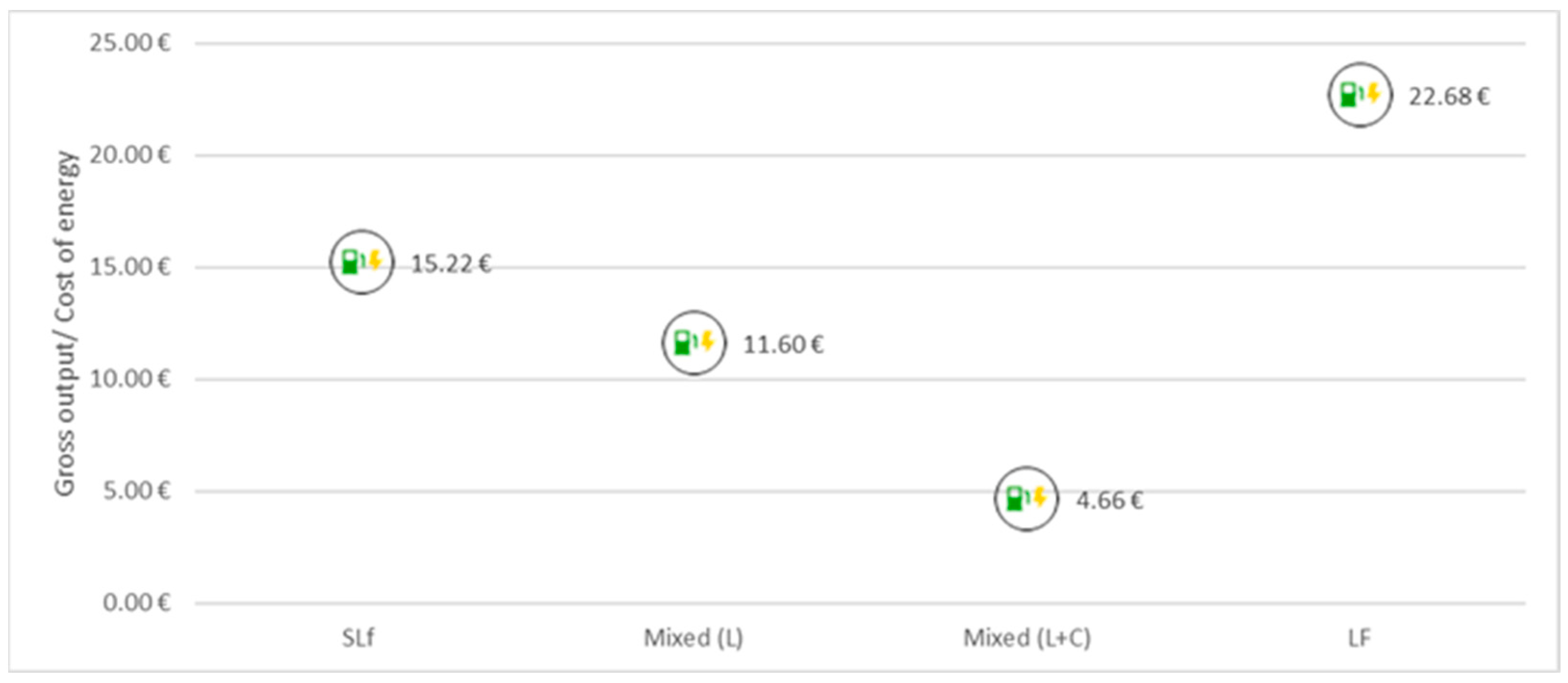
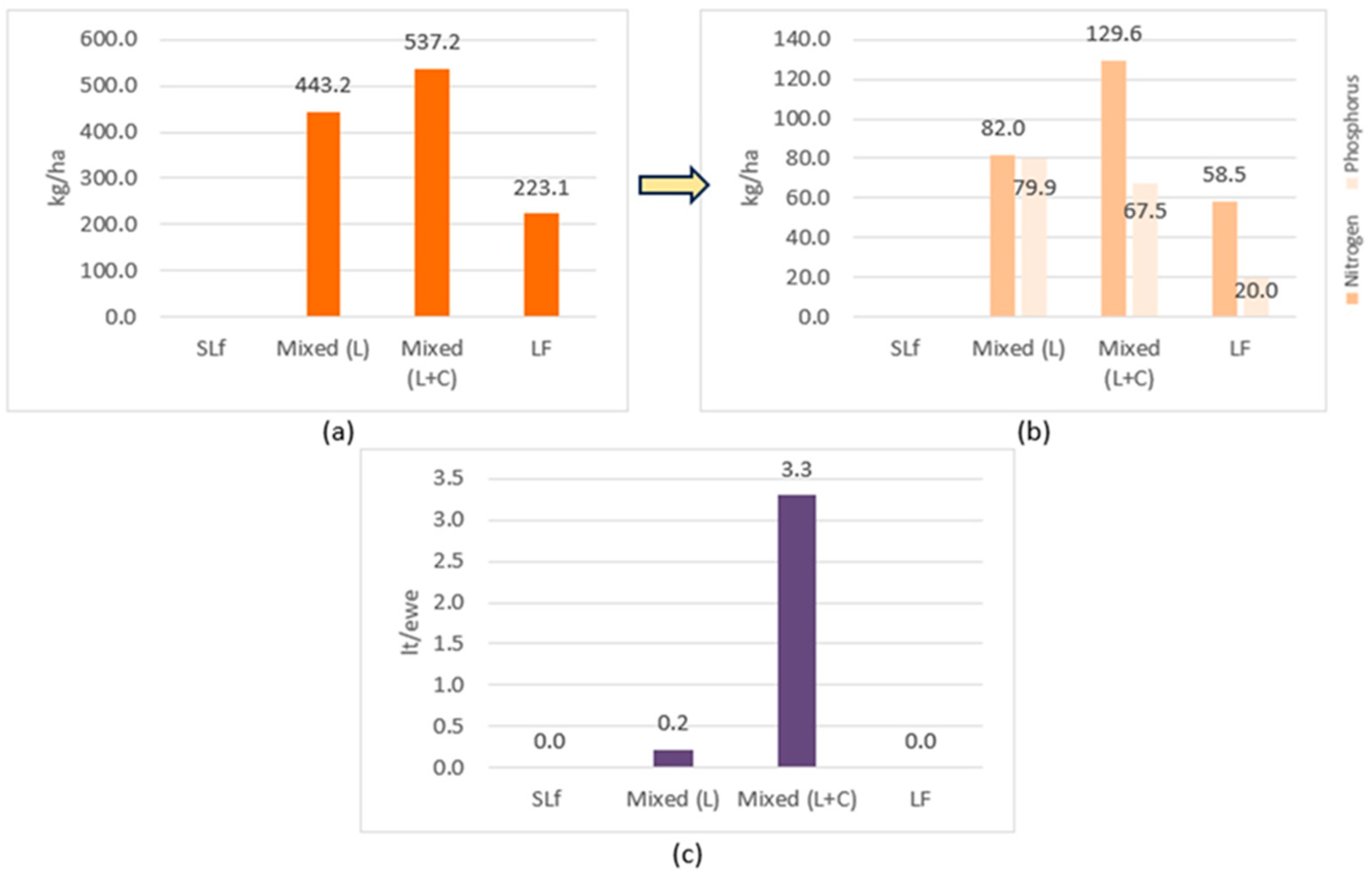
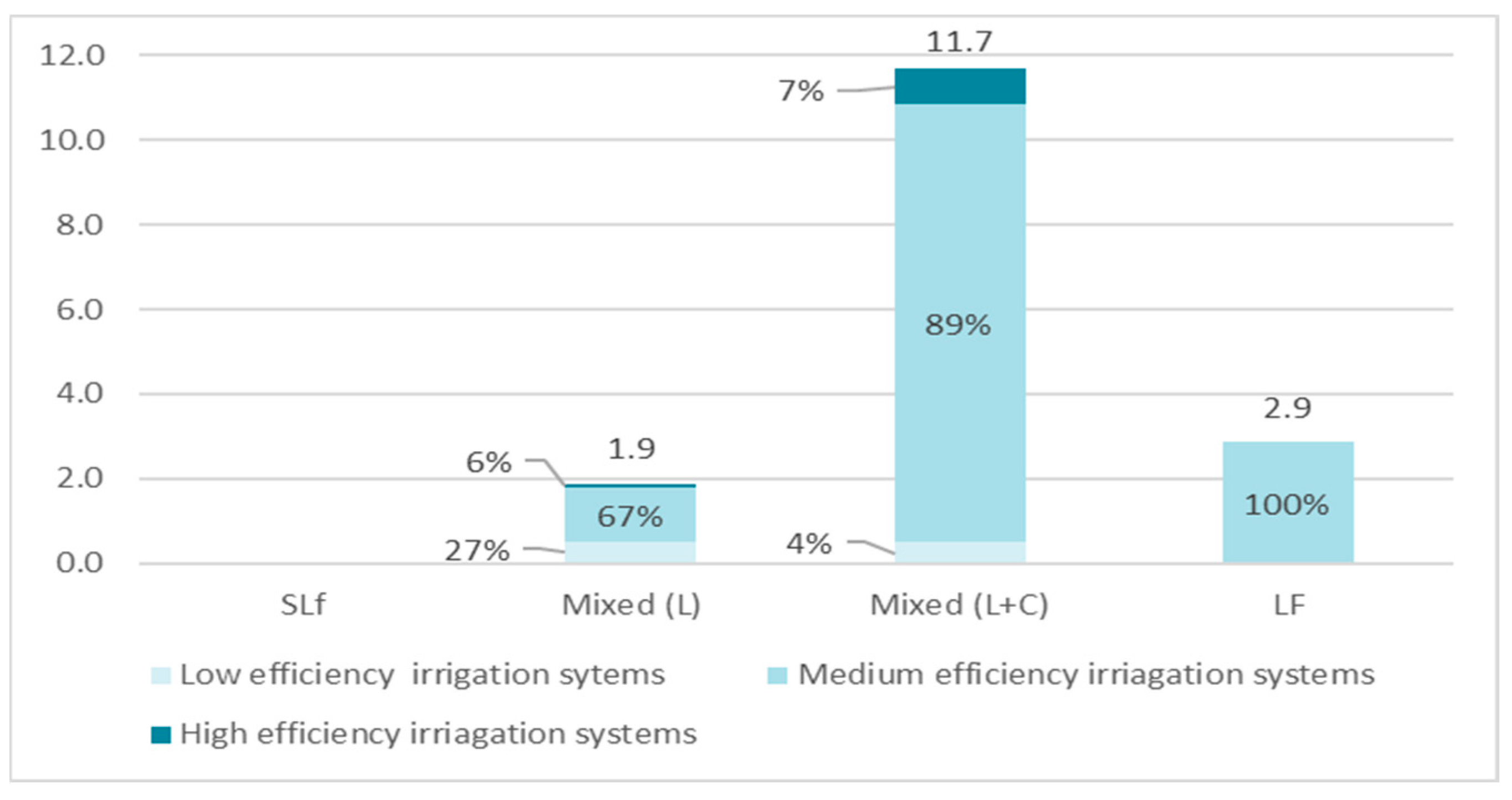
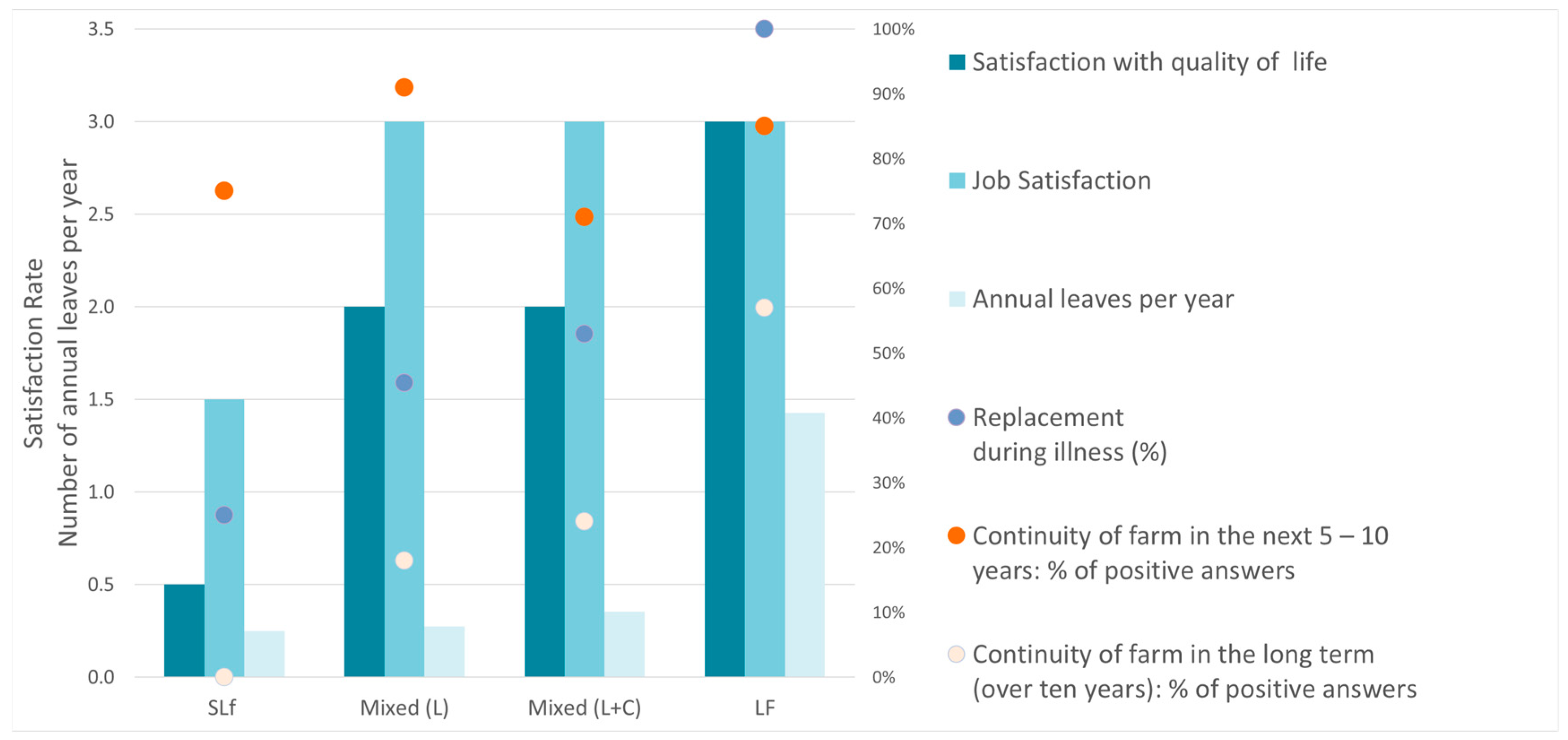
| Year | Purebred Breed Karagkouniko Sheep Registered in the Herdbook | Number of Karagkouniko Farms |
|---|---|---|
| 2011 | 8451 | 77 |
| 2012 | 5714 | 60 |
| 2015 | 4482 | 48 |
| 2017 | 4412 | 51 |
| 2019 | 4709 | 42 |
| 2020 | 4511 | 43 |
| 2021 | 4653 | 46 |
| 2022 | 4319 | 44 |
| Indicators | SLf | Mixed (L) | Mixed (L + C) | LF |
|---|---|---|---|---|
| Gross revenues with Income Support (EUR/ewe) | EUR 286.77 | EUR 281.03 | EUR 551.37 | EUR 481.53 |
| Income Support (EUR/ewe) | EUR 43.47 | EUR 59.61 | EUR 112.67 | EUR 46.88 |
| Total production cost (EUR/ewe) | EUR 280.25 | EUR 359.36 | EUR 696.13 | EUR 476.73 |
| Purchased feedstuff expenses (EUR/ewe) | EUR 99.87 | EUR 84.83 | EUR 43.85 | EUR 276.67 |
| Other production expenses (EUR/ewe) | EUR 180.38 | EUR 274.53 | EUR 652.28 | EUR 200.06 |
| Net profit/loss with Income Support (EUR/ewe) | EUR 6.51 | EUR −78.36 | −144.76 € | 4.80 € |
| Farm family income with Income Support (EUR/ewe) | EUR 93.08 | EUR 70.77 | 78.70 € | 63.88 € |
| Milk yield (liters/ewe) | 186.3 | 160.3 | 160.0 | 383.4 |
| No. Income sources (Scale) | 1.0 | 1.0 | 3.4 | 1.0 |
| Subsidy dependence (%) | 15% | 21% | 20% | 10% |
Disclaimer/Publisher’s Note: The statements, opinions and data contained in all publications are solely those of the individual author(s) and contributor(s) and not of MDPI and/or the editor(s). MDPI and/or the editor(s) disclaim responsibility for any injury to people or property resulting from any ideas, methods, instructions or products referred to in the content. |
© 2025 by the authors. Licensee MDPI, Basel, Switzerland. This article is an open access article distributed under the terms and conditions of the Creative Commons Attribution (CC BY) license (https://creativecommons.org/licenses/by/4.0/).
Share and Cite
Skordos, D.; Ragkos, A.; Karanikolas, P.; Vlahos, G. Sustainability Indicators of Different Production Systems of a Greek Local Sheep Breed. Sustainability 2025, 17, 604. https://doi.org/10.3390/su17020604
Skordos D, Ragkos A, Karanikolas P, Vlahos G. Sustainability Indicators of Different Production Systems of a Greek Local Sheep Breed. Sustainability. 2025; 17(2):604. https://doi.org/10.3390/su17020604
Chicago/Turabian StyleSkordos, Dimitrios, Athanasios Ragkos, Pavlos Karanikolas, and George Vlahos. 2025. "Sustainability Indicators of Different Production Systems of a Greek Local Sheep Breed" Sustainability 17, no. 2: 604. https://doi.org/10.3390/su17020604
APA StyleSkordos, D., Ragkos, A., Karanikolas, P., & Vlahos, G. (2025). Sustainability Indicators of Different Production Systems of a Greek Local Sheep Breed. Sustainability, 17(2), 604. https://doi.org/10.3390/su17020604







